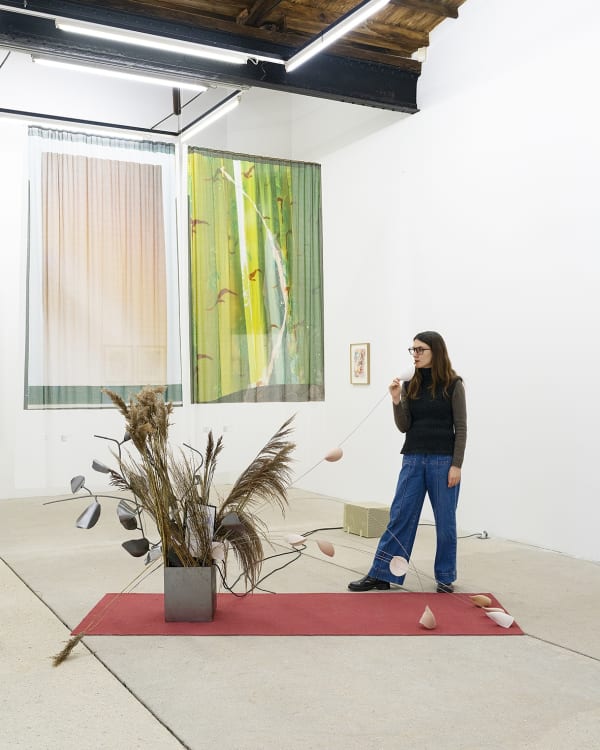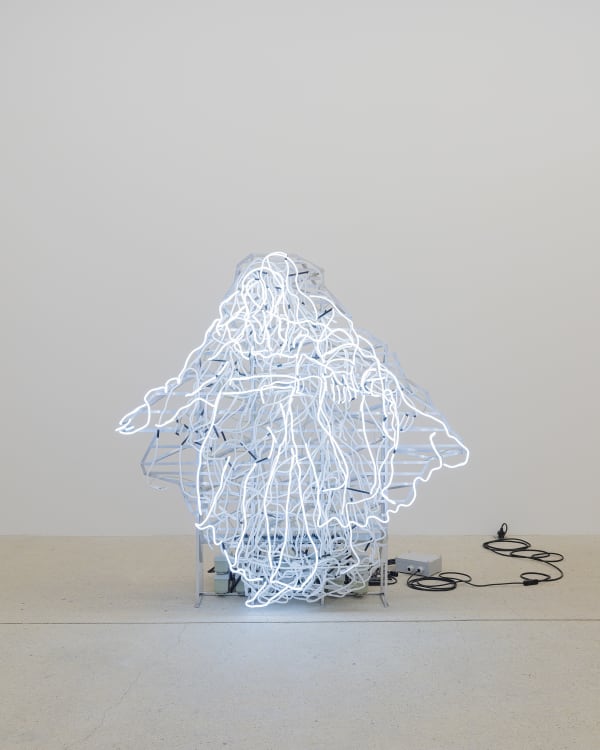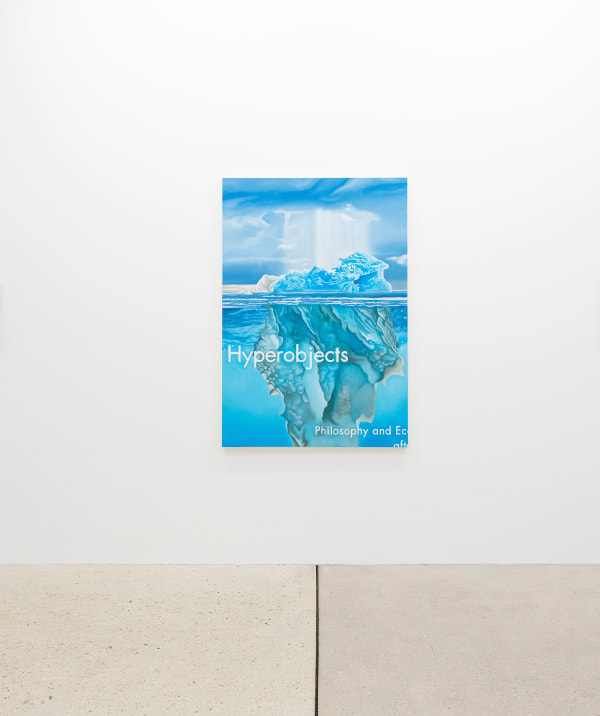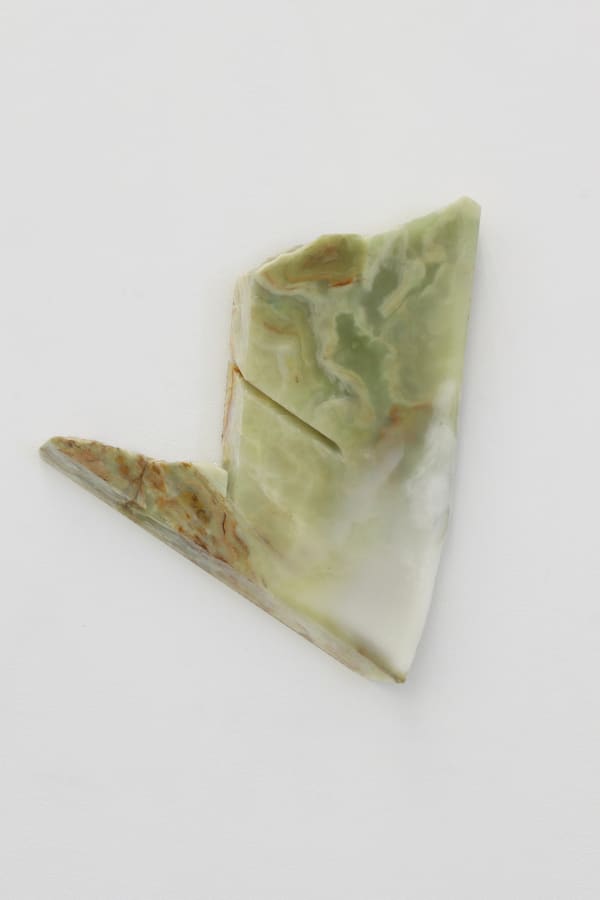Interfluvia: Ketuta Alexi-Meskhishvili, Mathias Augustyniak, Chloé Delarue, Anne Le Troter, Yoan Mudry, Sergiu Ujvarosi, and Bojan Šarčević.
galerie frank elbaz is pleased to present Interfluvia, a group exhibition featuring an eclectic selection of works by Ketuta Alexi-Meskhishvili, Mathias Augustyniak, Chloé Delarue, Anne Le Troter, Yoan Mudry, Sergiu Ujvarosi, and Bojan Šarčević. Designed as a meeting ground, the exhibition highlights the unique artistic approaches of each artist while celebrating the diversity of their interdisciplinary practices.
The works, crafted from a variety of materials – marble, neon, clay, aluminum, plants, textiles – convey a sense of tangible reality while instilling a sense of boundless time and space. Each piece invites viewers into a singular microcosm, revealing an intimate facet of the artist’s universe. Although these universes are distinct, they share a common grounding in the present moment, drawing from nature and its relationship to contemporary dynamics. They exist as a coherent reality, independent of reality itself, allowing viewers to mentally project themselves beyond the exhibition space.
-
 Ketuta Alexi-Meskhishvili, Heinrich-Heine-Strasse (Aldi), 2019
Ketuta Alexi-Meskhishvili, Heinrich-Heine-Strasse (Aldi), 2019 -
 Ketuta Alexi-Meskhishvili, Tbilisi still life, 2019
Ketuta Alexi-Meskhishvili, Tbilisi still life, 2019 -
 Yoan Mudry, Hyperobjects, 2023
Yoan Mudry, Hyperobjects, 2023 -
 Yoan Mudry, Tree Sneezing, 2023
Yoan Mudry, Tree Sneezing, 2023
Interfluvia
Ketuta Alexi-Meskhishvili, Mathias Augustyniak, Chloé Delarue, Anne Le Troter, Yoan Mudry, Sergiu Ujvarosi, and Bojan Šarčević
February 1 - March 15, 2025
Opening on February 1, from 6 PM to 8 PM
galerie frank elbaz is pleased to present Interfluvia, a group exhibition featuring an eclectic selection of works by Ketuta Alexi-Meskhishvili, Mathias Augustyniak, Chloé Delarue, Anne Le Troter, Yoan Mudry, Sergiu Ujvarosi, and Bojan Šarčević. Designed as a meeting ground, the exhibition highlights the unique artistic approaches of each artist while celebrating the diversity of their interdisciplinary practices.
The works, crafted from a variety of materials - marble, neon, clay, aluminum, plants, textiles - convey a sense of tangible reality while instilling a sense of boundless time and space. Each piece invites viewers into a singular microcosm, revealing an intimate facet of the artist's universe. Although these universes are distinct, they share a common grounding in the present moment, drawing from nature and its relationship to contemporary dynamics. They exist as a coherent reality, independent of reality itself, allowing viewers to mentally project themselves beyond the exhibition space.
The title of the exhibition, Interfluvia, refers to a fertile area located between two neighboring rivers, where flows and transformations converge. This scientific metaphor unfolds as a space for artistic exploration, where the natural cycles of life - exchanges, metamorphoses, regenerations, energies - materialize in the form of artworks. Motifs of icebergs, tropical plants, flowers, specters, and raw and transformed materials such as clay, marble, dried plants, aluminum, glass, and rubber engage in a dialogue with nature and its perpetual rhythms.
Press contact: kim@galeriefrankelbaz.com or + 33 (0)1 48 875004
Ketuta Alexi-Meskhishvili (born in 1979 in Tbilisi) is a Georgian-American photographer based in Berlin. Her work lies at the intersection of analog and digital photography. The images she captures range from candid, spontaneous moments to meticulously composed photographs, which are then subjected to manual, digital, or hybrid modifications. By intentionally leaving behind the marks of her unconventional production process she allows these material traces to shape the subject matter. This friction between light and dark, transparency and obstruction, plays a central role in her work, drawing attention to the physicality of the photographic process itself.
Her focus on transparency is particularly evident in her large-scale prints of diaphanous curtains, where the interplay between the printed image and the layers of translucency creates a sense of depth and mystery. The presence of imperfections-knife cuts, scratches, traces from the clips that held the negative, or the black framing of the Kodak film -further disrupts the notion of a flawless image, challenging conventional ideals of precision and perfection in photography.
Alexi-Meskhishvili's work, with its emphasis on surface, mystery, and perception, conveys something elusive, "outside of language and categorization." It resists easy interpretation, offering an experience that is "other than information,[1]" and stands in stark contrast to the polished, controlled aesthetics of more traditional photography.
Mathias Augustyniak (born in 1967 in Cavaillon, France) lives and works in Paris. In 1992, he co-founded the studio M/M (Paris) with Michaël Amzalag.
For the past fifteen years, Augustyniak has been developing a drawing practice that plays a key role in his artistic research, driven by a desire to create a universal language. His work exists at the intersection of typography and drawing, dissolving the boundaries between the two. Letters and words become drawings, while drawings, in turn, take on the qualities of language.
This approach was central to his drawn alphabet, created for Les 1001 desseins de l'ABCD'Orsay (2023) at the Musée d'Orsay. In this project, each letter embodied an artist-not through physical resemblance, but through an assemblage of visual elements drawn from their pictorial work, evoking their artistic universe. These hybrid compositions form a visual lexicon, where drawing becomes a means of revealing and transmitting the memory of artworks.
With his new series, Attempt to Draw a Circle, Augustyniak extends this research by freeing himself from typographic constraints. He develops a universe where figurative and abstract forms intertwine, merging body fragments, fauna, and flora into compositions where the line between writing and drawing dissolves, reinforcing his exploration of a universal visual language.
Chloé Delarue (born in 1986 in Le Chesnay, France) lives and works in Geneva, Switzerland. Delarue explores the aesthetic dimension of our emotions through a wide range of materials. She imagines scenarios and hypotheses about how our systems and structures of representation are reconfigured, becoming a substance or material that is accessible to the computational modes of our existence.
TAFAA - SIGNAL (Ice Cream So Good) stages a hybrid encounter between antagonistic female figures, reinterpreted by generative artificial intelligence. These figures embody notions of transcendence, power, and influence-spiritual, social, and technological. They blur the boundaries between the real and the simulated, the human and the divine, the existing and the artificially created.
This neon sculpture, evoking a spectral presence, draws inspiration from medieval imagery of the danse macabre and its contemporary reinterpretations in virtual worlds. The slender silhouettes, constructed in volume, intertwine and repeat in a circular motion. This animated, almost hypnotic round dance evokes trance or ritual dances.
Anne Le Troter (born in 1985 in Saint-Étienne, France) lives and works in Paris. Shaped by an eclectic heritage, her work intersects sound poetry, conceptual art, choreography, and the performing arts. With a touch of mischief, she navigates different registers, oscillating between tenderness and rigor, creating works where form and content subtly resonate with each other.
In Racine, Pistil, Le Troter presents a unique immersive experience, blending sculpture and sound narrative. The tale embedded within the sculpture becomes audible when the visitor places a twig in their mouth, with its other end touching the sculpture. Through bone conduction, the sound resonates directly in the ears, creating a sensory experience that is both intimate and physical.
The installation invites a consensual and tactile engagement through an erotic tale titled Pornoplante, intended for adults. This narrative plays with ASMR and audio pornography conventions, telling the story of a unique metamorphosis-an individual whose genitalia transforms into a plant, growing, blooming in the sun, and withering in autumn. Through this interaction, the artist explores the connections between the body, sound vibrations, desire, and transformation. The work literally invites the audience to "bite into the sound," blurring the boundaries between our different senses.
Yoan Mudry (born in 1990 in Lausanne, Switzerland) is a multidisciplinary artist based in Geneva. A graduate of the Geneva University of Art and Design (2014), he investigates the saturation of images, information overload, and the proliferation of narrative flows that shape contemporary life.
His work addresses the overwhelming presence of visual and cognitive stimuli, blending a wide range of sources-images and texts from the internet, comics, cartoons, art history, and more. While his practice primarily takes the form of painting, it also encompasses sculpture, performance, video, and installation, creating a dynamic, eclectic body of work.
This approach is exemplified in Tree Sneezing (2014), where Mudry assembles collages from diverse references, constructing a composition that finds meaning in the juxtaposition of elements. By capturing the flow of images and symbols, he underscores their complexity and reveals the cultural intersections they create.
Since 2018, Mudry has delved deeper into the relationship between images, knowledge, and power. His large-scale paintings, inspired by works from his personal library, explore themes such as propaganda, subliminal messaging, and image manipulation. A notable piece in this series, Hyperobjects (2018), incorporates the cover of Timothy Morton's book, examining the impact of images on our understanding of the world.
Mudry's recent paintings push this investigation further, offering a conceptual meditation on the power of images. Using book covers from his collection, he creates large-scale works that present his sources directly, forming a literal bibliography. By openly revealing the materials that inform his practice, Mudry merges content with form, seeking to transform the invisible forces at play in these images and their profound effects on our perceptions.
Sergiu Ujvarosi (born in 1997 in Baia Mare, Romania) lives and works in Paris. A graduate of the Beaux-Arts de Paris in 2022, he then joined a foundry, exploring new techniques and references.
With an approach akin to archaeology, Ujvarosi is drawn to found and collected residues, seeking to uncover the history embedded in matter. Through a study of morphology, he explores the relationship between the body and its environment: how it adapts to external conditions while simultaneously reflecting, containing, and being shaped by them. He collects and archives both organic materials and inorganic, manufactured elements, molding them in earth, thus embedding each piece in a cycle of imprint, erasure, and reinterpretation. His sculptures, appearing as though unearthed, speak to an uncertain past, where the origin of the material merges with its transformation.
The work Channeling fully embraces this methodology. Crafted from wild animal bones molded in earth and cast in aluminum, the piece continues Ujvarosi's ongoing exploration of earth as a universal matrix, symbolizing cycles of disappearance and resurgence. The deliberate preservation of soil residues on the sculptures imparts a fossil-like quality, where the hybrid material fluctuates between the traces and evidence left by time and transformation. Neither a series nor a defined ensemble, Channelingunfolds as an open form, ever-expanding and full of potential. Between sculpture and relic, Sergiu Ujvarosi's work interrogates the lasting impressions that matter retains from time's passage.
Bojan Šarčević (born in 1974) lives and works in Berlin, Germany, and Paris, France. The plurality of Bojan Šarčević's practice is rooted in a fundamental relationship with sculpture, materiality, and space, questioning their political, social, and poetic implications. He is interested in the ideological resonances and cultural displacements carried by forms, materials, and structures.
The Rhombic Oath sculptures are made from onyx marble fragments, recovered as leftovers from the fabrication of previous sculptures. These fragments, preserved for reuse, reveal a unique pictorial quality inherent to the stone itself. Covered with a thin layer of wax, they acquire a slightly milky, translucent, almost ethereal surface. This treatment enhances their immaterial quality and invites intimate contemplation. The inspiration for these sculptures also comes from Brice Marden's paintings, created in 1983 in Greece on fragments of marble. This dialogue between raw material and artistic intervention reveals a new approach to transforming natural elements.























